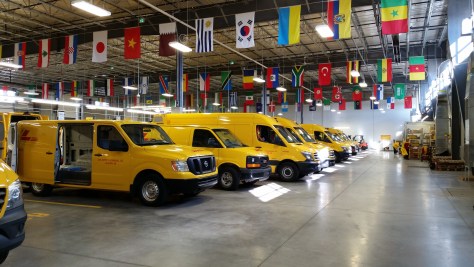Calgary Takes Aim at Transportation and Logistics
The news out of Calgary, Alberta, last week was of the groundbreaking for a new distribution center for Whirlpool Canada at the Canadian National Railway’s Calgary Logistics Park.
Whirlpool’s 425,000-square-foot facility will serve as a DC for finished Whirlpool appliances coming to Alberta from across North America. Locating the new regional distribution center at the logistics park provides the company “direct connection to CN’s rail network and transportation services, allowing us to deliver our appliances for our retail partners more efficiently and reliably,” noted Stephen Stewart, director of supply chain at Whirlpool Canada.
The Whirlpool news was emblematic of Calgary’s efforts to beef up its image and infrastructure as a logistics hub for western Canada. Oil was once king in Calgary, and it may yet resume that position, but plummeting prices have taken much of the strength out of that industry. Despite early projections to the contrary, oil prices have continued to move in the wrong direction in the last few months. That means that, not only has drilling and exploration in Alberta’s tar sands been compromised, but also that exploration and drilling equipment manufactured in the province are no longer headed to places like the Middle East and Africa in large volumes.
“The local economy is sputtering,” said Doug Romanuk, vice president, western region, of Bison Logistics, one of Canada’s largest trucking companies. “There are signs of of life in some areas and downturns in others.
“The downturn in the oil patch has caused us to redefine ourselves,” Romanuk added, referring not only to his company but to the Calgary region as a whole. “Calgary has become a big distribution hub. It’s a very progressive city and it’s supported by the surrounding counties.”
“Three or four years ago we were moving more cargo to Africa and the Middle East where the drilling was happening,” said Warren Tiede, manager of cargo services in Calgary for Air Canada. “The oil industry was hot when oil was $100 per barrel. But our business changes as the economy changes.”
Opened in 2013, the Calgary Logistics Park, located between the Canadian ports of Prince Rupert and Vancouver and major cities across Canada and the US Midwest, provides shippers a direct connection to CN’s rail network. The availability of land in the Calgary area is one factor that lends the city to become a transportation and logistics hub, as evidenced not only by CN’s logistics park, but by an even newer logistics center at Calgary International Airport (YYC).
Air cargo handlers like Air Canada and DHL have moved to a new apron at the international airport to take advantage of newer, more modern facilities and other logistical advantages the new location provides. YYC moved over 137,000 tons of cargo in 2016.

Air Canada moved into its new facility four years ago, and, at 7,000 square feet, is 4,000 square feet larger than its previous location. The new location includes a 700 square-foot cooler, allowing the airline to provide a solution for “pretty much every kind of cargo,” said Tiede, “from general cargo to human remains to chilled pork and horse meat.”
Besides being bigger, the new facility boasts open space, as opposed to the individual bays that characterized the older building, making it easier and faster to move cargo around. Since moving into the new building, Air Canada has designated Calgary as a hub, providing flights to and from Asia and better connections to Europe.
DHL also moved its facility from Apron 2 to the new Apron 9, taking 37,000 square feet of 100,000 square feet of new space, and tripling its operational area. The move has provided significant advantages to the company and its customers, according to James Craig, Western Canada operations manager at DHL.
The new location is 20 minutes closer to downtown, making it easier for customers who want to come in and pick up their packages and saving time for couriers rushing deliveries to their destinations. It also allows DHL to offer a later cut-off time for outbound shipments. Canada Customs is located right next door, making it easier to resolve any issues involving that agency.
“It has made us more efficient in the marketplace and we’re stealing market share from others,” said Craig.” DHL is growing at double digits in Calgary, he added, while the industry average stands at less than two percent.

The Canadian National logistics park was also relocated to allow for expansion. That allows CN to accommodate a 10,000-foot train on a single track. Previously, the tracks were 4,000 feet long and it took a few hours to cut the train before it could be unloaded.
Another advantage of the current location is to collocate distribution facilities with the CN terminal. “We are able to make use of a shunt move between the terminal and the facility,” said Tony Bianco, CN’s director of domestic intermodal sales, “and that reduces the costs on each container coming in and out of the facilities” by as much as 70 percent. It also makes the contents of the container available that much quicker.
The park, located to the northeast of downtown, where much of Calgary’s industrial capacity is now growing, serves manufacturers and retailers that demand speed of product to store shelves, noted Bianco. “Our success in this area is largely as a result of the unique train packages we’ve put together for customers,” he said. The facility is also located within a free trade zone.
Bianco foresees Calgary increasingly becoming the destination of containers railed from west-coast ports for further inland distribution. Today, import containers are often transported to central Canada for further distribution across the country, including back to Calgary and the west.
“We are marketing this capability to large retail and manufacturing customers who want operational flexibility and efficiency,” said Bianco.
It’s possible that one day oil prices will increase and Calgary will be resurrected as the petroleum capital of western Canada. “Once that happens, I’d bet dollars to donuts that more oil-related cargo will be coming in,” said Air Canada’s Tiede.
In the meantime, Calgary is betting on transportation and logistics. The proof: the city council’s most recent capital spending plan makes transportation the city’s number one priority.





Leave a Reply